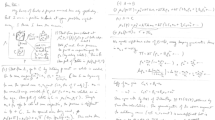Summary
It has been shown thermodynamically, and illustrated by means of a typical example, that the preferential attraction between hydrophobic determinants immersed in water, commonly alluded to as the “hydrophobic effect”, can be entirely ascribed to van der Waals interactions. Quantitatively, in water, the attraction between two hydrophobic determinants is stronger than the attraction between a hydrophobic and a hydrophilic determinant, although the latter attraction is not so small as to be negligible. The interaction between hydrophilic determinants in water is attractive but small and may be easily overwhelmed by the electrostatic repulsion which occurs between such entities.
There is no repulsion by the solvent. On the contrary, the attraction between water and a hydrophobic material as well as between water and a hydrophilic material is strong. This interaction does play a role in determining the overall strength of the interaction between hydrophobic and hydrophilic determinants but cannot render the attraction between such determinants negligible. The attraction between hydrophobic and hydrophilic determinants in an aqueous medium can be made exeedingly small and may indeed (after lowering the surface tension of the liquid) be changed into a repulsion. The latter phenomenon is used in the elution step of the protein separation method called “hydrophobic chromatography”.
Zusammenfassung
Es wird auf thermodynamischer Grundlage gezeigt und an Hand eines typischen Beispiels erläutert, daß die Anziehung zwischen hydrophoben Partikel in Wasser vollständig durch van der Waals-Wechselwirkungen erklärt werden kann. Die Anziehung zwischen solchen Teilchen oder Molekülen ist stärker als die Anziehung zwischen hydrophoben und hydrophilen Partikeln in Wasser, die jedoch nicht vernachlässigbar klein ist. Die Wechselwirkung zwischen hydrophilen Partikeln ist so klein, daß sie leicht von elektrostatischen Wechselwirkungen überdeckt werden kann.
Eine Abstoßung durch das Lösungsmittel findet nicht statt. Im Gegenteil, die Anziehung zwischen Wasser und einem hydrophoben Material ebenso wie diejenige zwischen Wasser und einem hydrophilen Material ist beträchtlich. Diese Wechselwirkung spielt zwar eine Rolle in der gesamten Wechselwirkung zwischen hydrophoben und hydrophilen Partikeln, kann aber die Anziehung zwischen hydrophob und hydrophil in Wasser nicht zum Verschwinden bringen. Die Wechselwirkung zwischen hydrophob und hydrophil kann jedoch durch Erniedrigung der Oberflächenspannung des Wassers abstoßend gemacht werden. Dieser Umstand wird im Elutionsschritt des als “hydrophobe Chromatographie” bekannten Verfahrens zur Trennung von Proteinen benutzt.
Similar content being viewed by others
References
Tanford, C., The Hydrophobic Effect: Formation of Micelles and Biological Membranes, Wiley-Intersciences, (New York, 1973).
Tanford, C., Science200, 1012 (1978).
Franks, F., Nature270, 386 (1977).
Hildebrand, J. H., J. Phys. Chem.72, 1841 (1968).
Hildebrand, J. H., Proc. Natl. Acad. Sci., U.S.A.76, 184 (1979).
Hamaker, H. C., Physica4, 1058 (1937).
Neumann, A. W., S. N. Omenyi, C. J. van Oss, Colloid Polymer Sci.257, 413 (1979).
van Oss, C. J., S. N. Omenyi, A. W. Neumann, Colloid Polymer Sci.257, 737 (1979).
van Oss, C. J., A. W. Neumann, S. N. Omenyi, D. R. Absolom, Separ. Purif. Method.7, 245 (1978).
Israelachvili, J. N., J. Chem. Soc. Faraday Trans. II,69, 1729 (1973).
Israelachvili, J. N., Quart. Rev. Biophys.6, 341 (1974).
Neumann, A. W., R. J. Good, C. J. Hope, M. Sejpal, J. Colloid Interf. Sci.49, 291 (1974).
Visser, J., Adv. Colloid Interf. Sci.3, 331 (1972).
Colacicco, G., Ann. N.Y. Acad. Sci.195, 224 (1972).
van Oss, C. J., J. M. Singer, J. Reticuloendothelial Soc.3, 29 (1966).
van Oss, C. J., D. R. Absolom, A. W. Neumann, Separ. Sci. Technol.14, 305 (1979).
Derjaguin, B. J., Disc. Faraday Soc.13, 85 (1954)
Visser, J., Rep. Progr. Appl. Chem.53, 714 (1968).
Visser, J., in:E. Matijević, Ed.: Suface and Colloid Science p. 3, Wiley-Interscience, (New York 1976).
Fowkes, F. M., in:J. J. Burke, Ed.: Surfaces and Interfaces, Vol. 1, p. 197, Syracuse Univ. Press (New York 1967).
Omenyi, S. N., Attraction and Repulsion of Particles by Solidifying Melts, Ph. D. Dissertation, University of Toronto (1978).
van Oss, C. J., D. R. Absolom, A. L. Grossberg, A. W. Neumann, Immunol. Commun.8, 11 (1979).
Author information
Authors and Affiliations
Rights and permissions
About this article
Cite this article
van Oss, C.J., Absolom, D.R. & Neumann, A.W. The “hydrophobic effect”: Essentially a van der Waals interaction. Colloid & Polymer Sci 258, 424–427 (1980). https://doi.org/10.1007/BF01480835
Received:
Issue Date:
DOI: https://doi.org/10.1007/BF01480835




